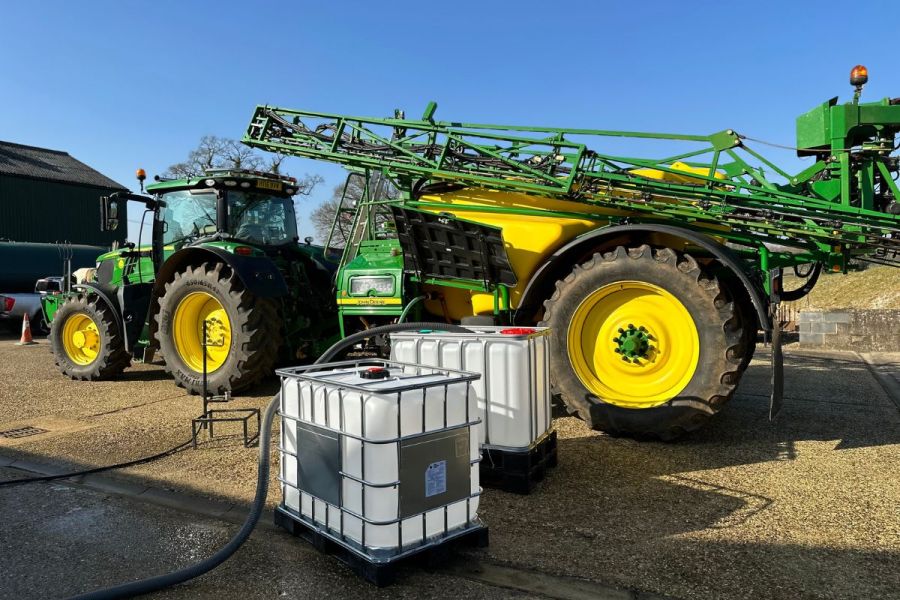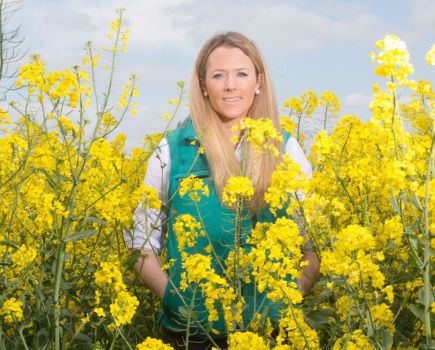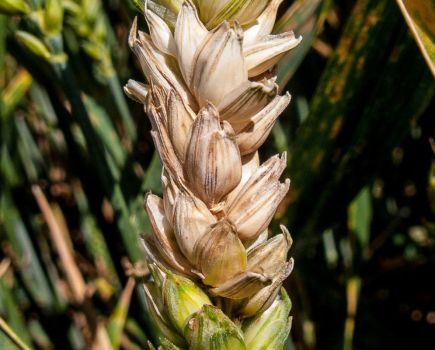It’s taken three decades from inception to UK industry adoption, but Closed Transfer Systems are here to stay. CPM explores how this technology came to fruition and the benefits it brings to operators, the environment and the industry alike.
“For the various challenges sprayer operators have, it’s an easier, quicker and safer system that requires minimal manual handling.”
By Melanie Jenkins
Modern sprayers are controlled by computers, guided by satellites, driven by highly skilled and qualified operators, but the method of adding chemicals to the sprayer hasn’t changed for more than 60 years – until now.
Health and safety is Frontier’s number one priority and underpins its initiative to roll out closed transfer systems (CTSs) adoption across the country, states the firm’s crop production technical lead Paul Fogg. “It’s estimated that minor injuries cost the industry £190-£200M a year, so anything we can adopt to reduce this will not only benefit agriculture as a whole, but also improve safety for operators.
“The industry has moved away from lugging around 50kg bags of fertiliser to these being delivered in 0.5-1t bags that are mechanically handled, so why is it that farmers and operators still have to heave 5-20-litre ag-chem packs around?”
Almost everything on farm is now mechanically handled, except for pesticides, agrees Richard Garnett of Wisdom Systems. “The industry has realised that it doesn’t have to wash out and dispose of product container waste, that operators don’t have to risk exposure, and that accidental spills of these inputs can be altogether avoided to protect the environment, all while drastically improving productivity.”
Richard started developing CTS equipment after reading an article by HSE inspector, Dr David Left, who identified the key contamination risks of sprayer operations.
“The article flagged that almost 95% of spills occur when the cap is removed from the container. I believed that this issue deserved an engineer a solution that would keep operators safe and it would also help prevent concentrated pesticides escaping to water courses.”
Wisdom Systems’ CTS isn’t new technology; it’s been introduced to thousands of farms in overseas markets since the 1990s. So why has it taken so long to gain momentum in the UK?
“The issue with introducing new technology is that it involves change, disrupting the existing supply chains can be difficult,” says Richard. “When sprayers had no induction bowl as standard, operators didn’t see the benefit, but these soon became a requirement for all new sprayers and now operators wouldn’t be without one. We’re going through the same process with CTS now – in a few years’ time it’s likely to be part of using any sprayer.
“What really captured the attention of UK farmers was the support given to Certis Belchim by Frontier and Wisdom Systems to launch Crown MH (maleic hydrazide), a sprout suppressant for potatoes, in 600-litre intermediate bulk containers (IBCs) as well as in 20-litre containers during 2021. Following the reapproval process with CRD, this required a CTS rather than 15-litre containers,” he explains. “The IBC was ideal for this product and a Wisdom CTS made loading it into the sprayer very clean and quick.”
Richard says once potato growers saw the improvement in productivity, many wanted other crop protection products delivered in the same containers.
“Once you have the system and the right packaging it improves efficiency by 20-40% – there’s nothing else you can buy or bolt on to a sprayer that’ll deliver the same amount of improvement,” he highlights. “This can mean adding an extra 40-80ha a day to your productivity. The opportunity to deliver greater efficiency on farm is being recognised by operators, and manufacturers are now reviewing their production processes to ensure the use of compatible containers.”
Businesses like Frontier are working to promote this technology too, helping to install it on farm to encourage operator safety, reduce plastic use, prevent pollution and potentially help extend the authorisation of products where there were previously concerns around safe handling and exposure.
Operator and environmental safety were the big drivers behind CTSs, says Paul. “Complete CTSs consist of tamper-proof sealed ICB units whereby chemical products essentially won’t see the light of day between the factory and when they’re applied. The industry-led easyconnect system differs in that this is a resealable cap for smaller pack sizes of under 10 litres which can be connected to various CTS units via their coupler. The same principles apply to both systems in terms of reducing operator exposure.”
This CTS equipment has been built and tested to meet International Organisation for Standardisation (ISO) and British Standards Institution (BSI) requirements and the expectations of industry regulators.
The demonstrated performance achieves a 95% reduction in exposure, explains Richard. “Essentially, CTS equipment provides a step-change in safely and effectively loading a wide range of crop protection and nutrition products into sprayers. This’ll hopefully help encourage new chemistry to become available and might even allow the industry to retain use of products that could otherwise be at risk of de-registration.”
In addition to removing exposure risks, using IBCs also means operators aren’t having to manually lift cans to empty them into the sprayer, and they aren’t having to twist caps or pull off foil seals while wearing rubber gloves, explains Frontier’s CTS specialist, Nick Badger. “For the various challenges sprayer operators have, it’s an easier, quicker and safer system that requires minimal manual handling.”
Paul feels that anything that can improve health and safety is worth adopting on farm. “Sprayer operators are trained experts and they’re becoming increasingly scarce, so any technology which makes things easier for them can only be a good thing.”
Through the use of CTSs, accuracy is also significantly improved. The FasTran 850 can bring flow accuracy to within +/- 0.5% while dispensing 25 litres/min, explains Nick. “The filling speed means operators can spray 1-2 extra tank loads per day because they don’t have to keep returning to the store to pour liquid from multiple cans which would also require triple rinsing.
“This is a major plus point when we’re seeing an increase in workloads or compressed spraying windows but not necessarily seeing sprayers upgraded to cope with these changes. Improving filling time is the only way operators can increase the output of a sprayer without purchasing a larger one.”
A further aspect of improved safety is the prevention of chemicals reaching water courses from point source contamination. ADAS research carried out in 2003 highlighted that pesticidal products were entering water courses via drains on farmyards as a result of everyday spills during dispensing, says Paul.
“The study highlighted that as much as 40% of the load of pesticides in water could be attributed to the filling area. Although we’re now more aware of the risks, accidents still happen.”
According to Nick, an innocent spill or drip can unfortunately result in potential damage to water bodies. “But using CTSs reduces exposure to the point that this risk is significantly reduced. Therefore, their use is a no-brainer from an environmental perspective.”
The industry is also under increasing pressure to cut its consumption of single-use plastics, highlights Paul. “Adopting CTS technology provides an opportunity to cut down in manufacturing and on farm, plus more besides.”
For starters, IBCs use significantly less plastic than small packs, says Nick. “A 600-litre IBC uses 20g of plastic per litre of product, whereas a 10-litre can uses 40g of plastic per litre, and this is based on the IBC being used once. As long as the CTS equipped IBC has the numbered security tag intact and the metal crimped ring over the valve has not been tampered with, Frontier will collect the container. If appropriate, the IBC can be refilled and redistributed back onto farm over a period of time, after which it can be recycled.”
“It’s not just operators who perceive this as a great idea, there are numerous businesses in the industry working towards reducing waste and improving operator safety,” he adds. “Using IBCs removes wooden pallets and shrink wrap therefore the requirement to manage their disposal too. It’s a far more sustainable way of handling products.”
Demonstrating Frontier’s commitments under its sustainability strategy ‘The Responsible Choice’, the business has worked with organisations such as Severn Trent Water to offer the FasTran 850 to farmers within its catchment area, says Nick.
“More than 500 farms have the FasTran 850 attached to IBCs, which started with Crown MH, but has expanded to Stabilan (chlormequat), Roundup Energy (glyphosate) and a range of nutrient products including manganese and magnesium.”
And whereas IBCs were historically available as 1000-litre units, Frontier has moved towards 600- litre IBCs to make adoption of the technology more flexible for farmers, he explains. “There are IBCs down to 300 litres and we’re currently evaluating the feasibility of a 50-litre returnable container.”
With the opening of the Farm Equipment and Technology Fund (FETF) in early March came the option to apply for 60% funding toward both the FasTran 850 and the easyconnect systems, says Nick. “Both are highly scored by Defra, meaning there’s a greater chance of securing funding for them. I think this demonstrates a desire from policymakers to improve operator safety and support greater efficiency.”
Enquiries for CTSs have increased considerably, and the grant funding demonstrates the industry and regulators are encouraging adoption as soon as possible, says Richard. “CTS has passed the point of being a technology in development, it’s fully operational. We’re now helping operators to retrofit their sprayers with CTS connections on a daily basis.”
Nick has also observed a plethora of interest since the launch of the FETF and notes that this supersedes owners and operators, extending to water companies and beyond. “Integrating CTSs across the sector is something appealing to the wider industry as a whole,” he concludes.
This article was taken from the latest issue of CPM. Read the article in full here.
For more articles like this, subscribe here.
Sign up for Crop Production Magazine’s FREE e-newsletter here.




